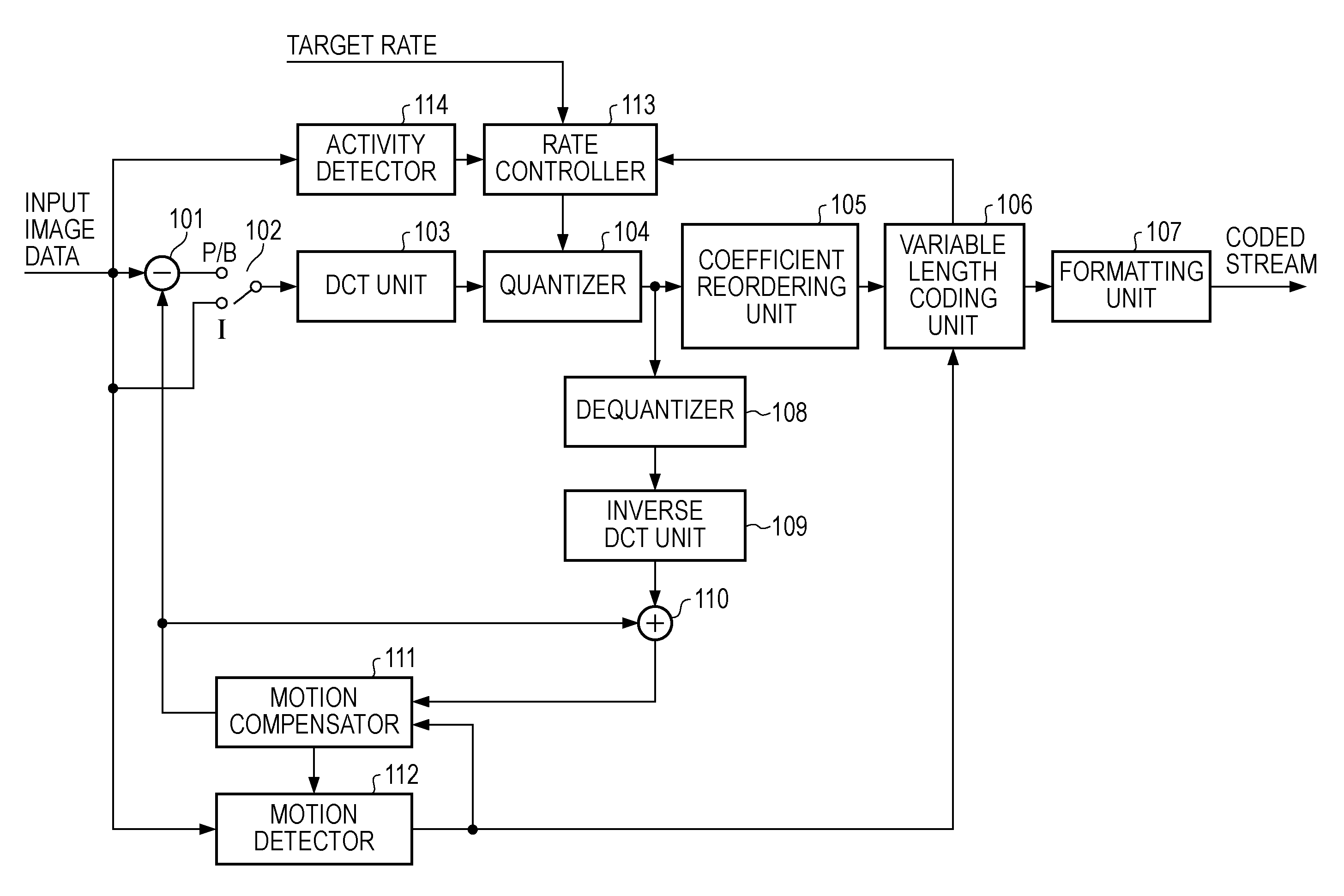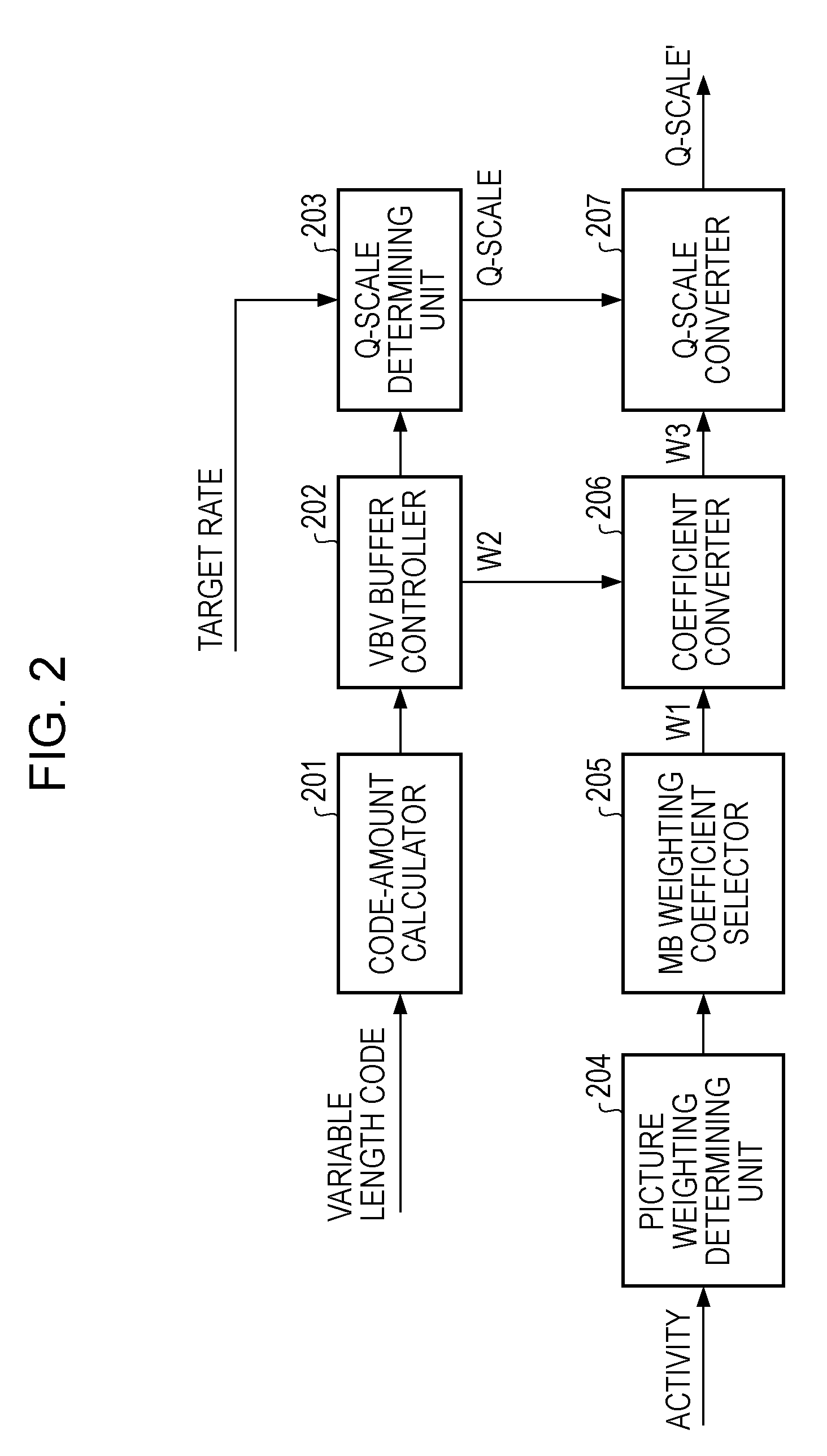Image processing apparatus
a technology of image processing and image signals, applied in the field of image processing apparatuses, can solve the problems of code generation variability, code underflow, etc., and achieve the effect of improving image quality
- Summary
- Abstract
- Description
- Claims
- Application Information
AI Technical Summary
Benefits of technology
Problems solved by technology
Method used
Image
Examples
first exemplary embodiment
[0036]FIG. 1 illustrates a configuration of a coding apparatus according to at least one exemplary embodiment of the present invention. The coding apparatus of FIG. 1 is capable of coding input moving image signals according to the MPEG2 standard.
[0037]Referring to FIG. 1, moving image data supplied from a video camera, an input terminal, or the like is input frame-by-frame and supplied to a subtracter 101, a switch 102, a motion compensator 111, a motion detector 112, and an activity detector 114.
[0038]In the MPEG2 standard, a moving image signal is coded frame-by-frame by the combination of intraframe coding (I-pictures), interframe forward predictive coding (P-pictures), and interframe bidirectional predictive coding (B-pictures).
[0039]For coding I-pictures, the switch 102 is connected to an “I” side and allows an input image signal of one frame to be directly supplied to a DCT unit 103. The DCT unit 103 performs DCT processing on each DCT block of the input image signal, each DC...
second exemplary embodiment
[0066]A second exemplary embodiment of the present invention will now be described. In the first exemplary embodiment described above, a weighting coefficient determined from the activity of an image is converted on the basis of the state of the VBV buffer. This can cause the value of W2 to be changed in the middle of one frame, and the improvement of image quality based on the use of activities may be less significant, particularly in MBs processed at a later stage in the processing of one screen.
[0067]Therefore, in the present exemplary embodiment, when the picture weighting determining unit 204 generates a weighting coefficient on the basis of an activity with respect to each MB, the activity to be supplied to the picture weighting determining unit 204 is converted according to the state of the VBV buffer.
[0068]FIG. 3 illustrates a configuration of a rate controller 113 according to the second exemplary embodiment. In FIG. 3, components similar to those of FIG. 2 are given the sa...
third exemplary embodiment
[0076]A third exemplary embodiment of the present invention will now be described. FIG. 6 illustrates a configuration of a rate controller 113 according to the third exemplary embodiment. In FIG. 6, components similar to those of FIG. 2 are given the same reference numerals.
[0077]Referring to FIG. 6, the Q-scale determining unit 203 determines a Q-scale in a similar manner to those of the foregoing exemplary embodiments and outputs the determined Q-scale to a switch 602.
[0078]On the other hand, the Q-scale converter 207 performs an operation using a weighting coefficient W1 for each MB output from the MB weighting-coefficient selector 205 and a Q-scale value from the Q-scale determining unit 203 in a similar manner to that described above, and outputs the resulting Q-scale′ to the switch 602.
[0079]Then, according to an instruction from a VBV buffer controller 601, the switch 602 selects either one of the Q-scale from the Q-scale determining unit 203 and the Q-scale′ from the Q-scale...
PUM
 Login to View More
Login to View More Abstract
Description
Claims
Application Information
 Login to View More
Login to View More - R&D
- Intellectual Property
- Life Sciences
- Materials
- Tech Scout
- Unparalleled Data Quality
- Higher Quality Content
- 60% Fewer Hallucinations
Browse by: Latest US Patents, China's latest patents, Technical Efficacy Thesaurus, Application Domain, Technology Topic, Popular Technical Reports.
© 2025 PatSnap. All rights reserved.Legal|Privacy policy|Modern Slavery Act Transparency Statement|Sitemap|About US| Contact US: help@patsnap.com



